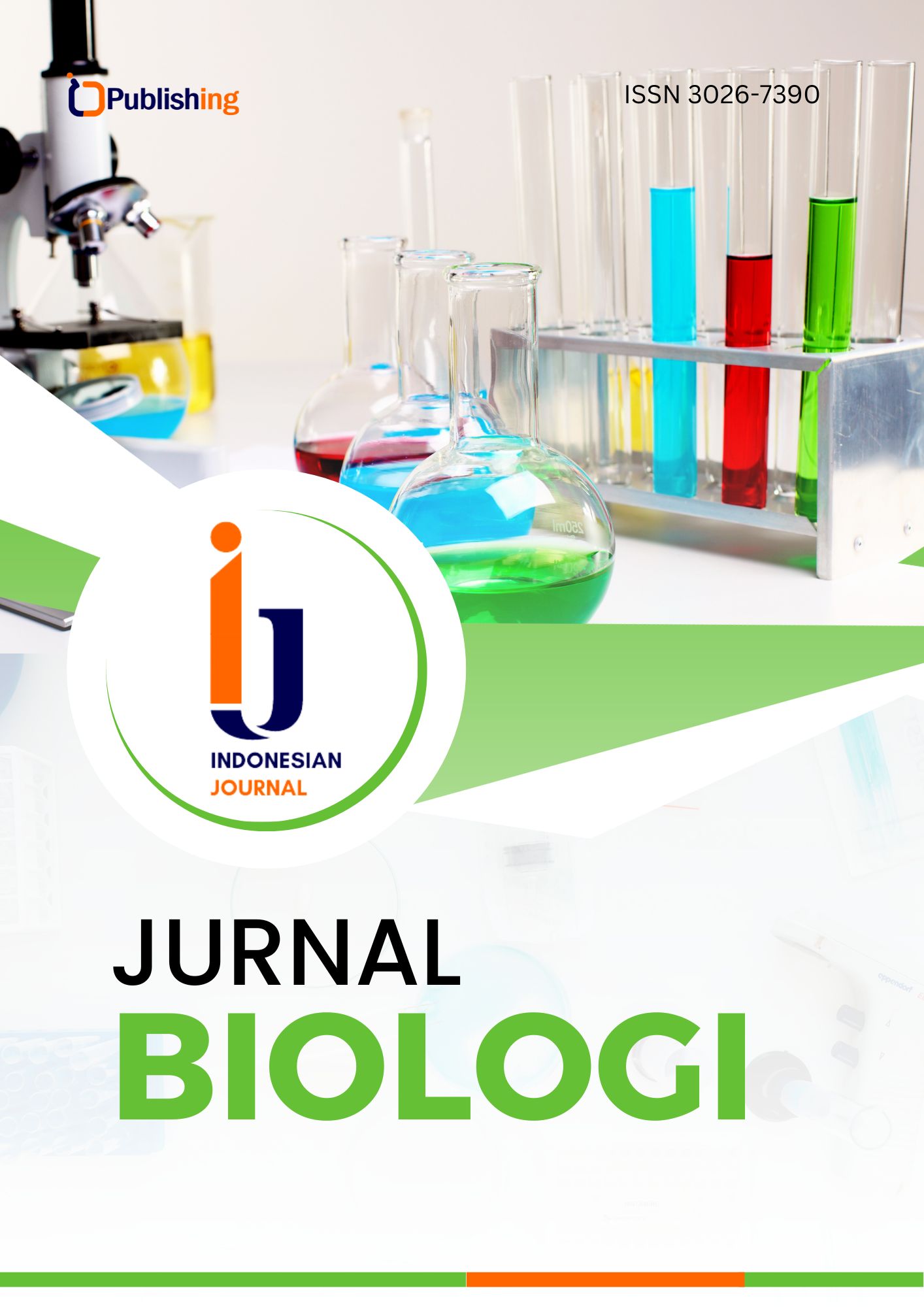Model Problem Based Learning (PBL) Dengan Pendekatan STEAM Sebagai Upaya Meningkatkan Keaktifan Belajar
DOI:
https://doi.org/10.47134/biology.v1i2.1959Keywords:
pendekatan STEAM, aktivitas siswa, ptk kolaboratifAbstract
Penelitian ini menggunakan metode penelitian tindakan kelas kolaboratif (ptkk) yang data awal sebagai acuan penelitian didapatkan dari pembelajaran pra siklus dilanjutkan dengan siklus I dan siklus II yang hasilnya diuraikan dalam bentuk deskriptif kualitatif. Teknik pengumpulan data menggunakan observasi dan dokumentasi kegiatan belajar peserta didik yang bertujuan untuk mendeskripsikan peningkatan keaktifan belajar biologi menggunakan model pembelajaran PBL dengan pendekatan STEAM. Subjek dalam penelitian ini adalah siswa kelas X.3 SMAN Jenggawah tahun ajaran 2022/2023 berjumlah 35 siswa dengan 13 siswa laki-laki dan 22 siswa perempuan. Hasil penelitian setiap siklus menunjukkan adanya peningkatan yang terjadi dari tahap pra siklus, awal siklus (siklus I) sampai tahap akhir (siklus II) melalui data hasil lembar observasi mengenai aktivitas siswa. Perubahan dalam tingkat keaktifan belajar peserta didik terlihat dari persentase siswa dengan kategori sangat aktif, aktif dan cukup aktif mengalami peningkatan persentase yang cukup signifikan yaitu dari 46 % pada pra siklus menjadi 95% pada siklus 2. Kesimpulan dari penelitian ini yaitu model PBL dengan pendekatan STEAM mampu meningkatkan keaktifan dalam proses pembelajaran.
References
Abula, K. (2018). Does knowledge of physical activity recommendations increase physical activity among Chinese college students? Empirical investigations based on the transtheoretical model. Journal of Sport and Health Science, 7(1), 77–82. https://doi.org/10.1016/j.jshs.2016.10.010 DOI: https://doi.org/10.1016/j.jshs.2016.10.010
Arifudin, O. (2020). Psikologi Pendidikan (Tinjauan Teori Dan Praktis). Widina Bhakti Persada.
Arlinghaus, K. R. (2021). Randomized Controlled Trial to Increase Physical Activity Among Hispanic-American Middle School Students. Journal of School Health, 91(4), 307–317. https://doi.org/10.1111/josh.13004 DOI: https://doi.org/10.1111/josh.13004
Balasekaran, G. (2021). Using brain-breaks® as a technology tool to increase attitude towards physical activity among students in Singapore. Brain Sciences, 11(6). https://doi.org/10.3390/brainsci11060784 DOI: https://doi.org/10.3390/brainsci11060784
Barrett, R. (2018). Social and Tactile Mixed Reality Increases Student Engagement in Undergraduate Lab Activities. Journal of Chemical Education, 95(10), 1755–1762. https://doi.org/10.1021/acs.jchemed.8b00212 DOI: https://doi.org/10.1021/acs.jchemed.8b00212
Degeng, S. I. N., Rinanityas, E. P., Prihatin Priawasana, M. A., & Usman, U. (2021). The Effect of PBL-based STEAM Approach on The Cognitive and Affective Learning Outcomes of Primary School. Turkish Journal of Computer and Mathematics Education (TURCOMAT), 12(6). DOI: https://doi.org/10.17762/turcomat.v12i6.5521
Elsayed, A. M. A. (2021). Can an educational activity program based on feuerstein’s program and gardner’s theory increase excellence and creativity in math in omani students? FWU Journal of Social Sciences, 15(3), 1–26. https://doi.org/10.51709/19951272/Fall-2021/1 DOI: https://doi.org/10.51709/19951272/Fall-2021/1
Heeren, G. (2018). Health-Promotion Intervention Increases Self-Reported Physical Activity in Sub-Saharan African University Students: A Randomized Controlled Pilot Study. Behavioral Medicine, 44(4), 297–305. https://doi.org/10.1080/08964289.2017.1350134 DOI: https://doi.org/10.1080/08964289.2017.1350134
Huang, X. (2021). Inadequate Mental Health Literacy and Insufficient Physical Activity Potentially Increase the Risks of Anxiety and Depressive Symptoms in Chinese College Students. Frontiers in Psychiatry, 12. https://doi.org/10.3389/fpsyt.2021.753695 DOI: https://doi.org/10.3389/fpsyt.2021.753695
Irwansyah, R. (2021). Perkembangan Peserta Didik. Widina Bhakti Persada.
Johnson, M. (2019). Video Activity Schedules to Increase Independence for Students with Disabilities. Journal of Developmental and Physical Disabilities, 31(1), 73–88. https://doi.org/10.1007/s10882-018-9631-z DOI: https://doi.org/10.1007/s10882-018-9631-z
Li, Z. (2020). Integrating role-playing gamification into programming activities to increase student engagement. ASEE Annual Conference and Exposition, Conference Proceedings, 2020. DOI: https://doi.org/10.18260/1-2--34847
Mo, D. (2019). Using gamification and social incentives to increase physical activity and related social cognition among undergraduate students in Shanghai, China. International Journal of Environmental Research and Public Health, 16(5). https://doi.org/10.3390/ijerph16050858 DOI: https://doi.org/10.3390/ijerph16050858
Murnane, K. S. (2019). A classroom activity to increase student pharmacists confidence in dealing with the opioid epidemic. American Journal of Pharmaceutical Education, 83(9), 1948–1957. DOI: https://doi.org/10.5688/ajpe7199
Musyadad, V. F. (2022). Supervisi Akademik untuk Meningkatkan Motivasi Kerja Guru dalam Membuat Perangkat Pembelajaran. JIIP-Jurnal Ilmiah Ilmu Pendidikan, 5(6), 1936–1941. DOI: https://doi.org/10.54371/jiip.v5i6.653
Osipov, A. (2018). Physical education and sports achievement ratings as a significant factor to increase the level of physical activity of students and staff in high school. Journal of Physical Education and Sport, 18(2), 592–599. https://doi.org/10.7752/jpes.2018.02086 DOI: https://doi.org/10.7752/jpes.2018.02086
Patmawati, P., & Meilinda, M. (2023). Meningkatkan Keaktifan Belajar pada Pelajaran Biologi Menggunakan Model Problem Based Learning disertai Media Video. Ideguru: Jurnal Karya Ilmiah Guru, 8(3), 569–576. DOI: https://doi.org/10.51169/ideguru.v8i3.625
PGSM, T. P. P. (1999). Penelitian tindakan kelas (Classroom action research). Proyek Pengembangan Guru Sekolah Menengah, Ditjen Dikti, Depdiknas.
Prameswari, T. W., & Lestariningrum, A. (2020). STEAM based learning strategies by playing loose parts for the achievement of 4c skills in children 4-5 years. Jurnal Efektor, 7(1), 24–34. DOI: https://doi.org/10.29407/e.v7i2.14387
Pujiono, S. (2008). Desain Penelitian Tindakan Kelas Dan Teknik Pengembangan Kajian Pustaka.
Salyani, R. (2020). Application of the 5E learning cycle model to overcome misconception and increase student learning activities in learning chemical bonding. Journal of Physics: Conference Series, 1460(1). https://doi.org/10.1088/1742-6596/1460/1/012102 DOI: https://doi.org/10.1088/1742-6596/1460/1/012102
Sari, D. K. (2022). Is It Important to Increase Physical Activity Among University Students During the Second-Wave COVID-19 Pandemic in Asian Countries? A Cross-Sectional Study of the Knowledge, Attitudes, and Practices in Asian Countries. Journal of Multidisciplinary Healthcare, 15, 1559–1571. https://doi.org/10.2147/JMDH.S368635 DOI: https://doi.org/10.2147/JMDH.S368635
Sudjana, N. (2007). Penilaian Hasil Proses Belajar Mengajar. Remaja Rosdakarya.
Syahidi, A. A. (2018). Applying Student Team Achievement Divisions (STAD) Model on Material of Basic Programme Branch Control Structure to Increase Activity and Student Result. IOP Conference Series: Materials Science and Engineering, 336(1). https://doi.org/10.1088/1757-899X/336/1/012027 DOI: https://doi.org/10.1088/1757-899X/336/1/012027
Toharudin, M., & Ahlul, R. (2020). Model Pendampingan Belajar Pada Anak Keluarga TKW Di SD Negeri Wanacala 02 Brebes. Jurnal Ilmiah KONTEKSTUAL, 2(1), 50–56. DOI: https://doi.org/10.46772/kontekstual.v2i01.249
Weaver, R. G. (2018). An Intervention to Increase Students’ Physical Activity: A 2-Year Pilot Study. American Journal of Preventive Medicine, 55(1). https://doi.org/10.1016/j.amepre.2018.03.005 DOI: https://doi.org/10.1016/j.amepre.2018.03.005
Yulianto, A., Fatchan, A., & Astina, I. K. (2017). Penerapan model pembelajaran project based learning berbasis lesson study untuk meningkatkan keaktifan belajar siswa. Jurnal Pendidikan: Teori, Penelitian, Dan Pengembangan, 2(3), 448–453.
Downloads
Published
How to Cite
License
Copyright (c) 2023 Ratna Sari, Sawitri Komarayanti, An Rini Mudayanti

This work is licensed under a Creative Commons Attribution 4.0 International License.









